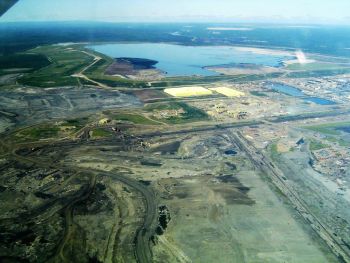Tailings Dams: Difference between revisions
Rmanwaring (talk | contribs) No edit summary |
No edit summary |
||
| (11 intermediate revisions by 4 users not shown) | |||
| Line 1: | Line 1: | ||
__NOTOC__ | __NOTOC__ | ||
[[Category:Types]] | |||
---- | ---- | ||
{{Picture | {{Picture | ||
|image= | |image= | ||
<!-- Add image file name (ex.image.jpg) --> | <!-- Add image file name (ex.image.jpg) --> | ||
tailings- | tailings-alberta.jpg | ||
|link= | |link= | ||
<!--https:// | <!--https://en.wikipedia.org/wiki/Tailings_dam--> | ||
|caption= | |caption= | ||
<!-- Add picture caption --> | <!-- Add picture caption --> | ||
Syncrude Tailings Dam; Fort McMurray, Alberta, Canada. | |||
(Image Source: [https://en.wikipedia.org/wiki/Tailings_dam Wikipedia]) | |||
}} | }} | ||
An industrial waste dam in which the waste materials come from mining operations or mineral processing. | An industrial waste dam in which the waste materials come from mining operations or mineral processing. | ||
“A tailings dam is a facility that is designed and managed to contain the tailings produced by a mine. A tailings facility includes the collective engineered structures, components, and equipment involved in the management of tailings solids, other mine waste managed with tailings (e.g. waste rock, water treatment residues), and any water managed in the facility, including pore fluid, any ponds, and surface water inflows and discharges”.<ref name="ICMM Tailing Management">[[ | “A tailings dam is a facility that is designed and managed to contain the tailings produced by a mine. A tailings facility includes the collective engineered structures, components, and equipment involved in the management of tailings solids, other mine waste managed with tailings (e.g. waste rock, water treatment residues), and any water managed in the facility, including pore fluid, any ponds, and surface water inflows and discharges”.<ref name="ICMM Tailing Management">[[Tailings Management: Good Practice Guide | Tailings Management: Good Practice Guide, ICMM, 2021]]</ref> | ||
==Life Cycle of Tailings Dams== | |||
*[[Design and Construction of Tailings Dams]] | |||
*[[O&M of Tailings Dams]] | |||
*[[Decommissioning Tailings Dams]] | |||
<noautolinks>==Best Practices Resources==</noautolinks> | |||
{{Document Icon}} [[Tailings Management: Good Practice Guide | Tailings Management: Good Practice Guide, ICMM]] | |||
{{Document Icon}} [[Global Industry Standard on Tailings Management | Global Industry Standard on Tailings Management, ICMM]] | |||
{{Document Icon}} [[Safety Guidelines and Good Practices for Tailings Management Facilities (ECE 1326665) | Safety Guidelines and Good Practices for Tailings Management Facilities (ECE 1326665), UN]] | |||
==Trainings== | |||
{{Video Icon}} [[On-Demand Webinar: Intro to Tailings Dam and Coal Ash Impoundment Design, Construction and Monitoring: What Can Go Wrong and Right?]] | |||
Citations: | Citations: | ||
<references /> | <references/> | ||
<!-- Revision history information --> | <!-- Revision history information --> | ||
{{revhistinf}} | {{revhistinf}} | ||
Latest revision as of 15:14, 21 August 2023

|
| Syncrude Tailings Dam; Fort McMurray, Alberta, Canada.
(Image Source: Wikipedia) |
An industrial waste dam in which the waste materials come from mining operations or mineral processing.
“A tailings dam is a facility that is designed and managed to contain the tailings produced by a mine. A tailings facility includes the collective engineered structures, components, and equipment involved in the management of tailings solids, other mine waste managed with tailings (e.g. waste rock, water treatment residues), and any water managed in the facility, including pore fluid, any ponds, and surface water inflows and discharges”.[1]
Life Cycle of Tailings Dams
Best Practices Resources
![]() Tailings Management: Good Practice Guide, ICMM
Tailings Management: Good Practice Guide, ICMM
![]() Global Industry Standard on Tailings Management, ICMM
Global Industry Standard on Tailings Management, ICMM
![]() Safety Guidelines and Good Practices for Tailings Management Facilities (ECE 1326665), UN
Safety Guidelines and Good Practices for Tailings Management Facilities (ECE 1326665), UN
Trainings
Citations:
Revision ID: 7644
Revision Date: 08/21/2023
